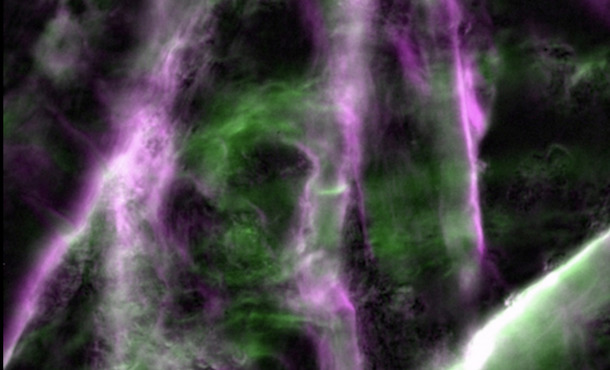
Cellulose in a plant cell wall after labeling with a fluorescent dye, showing differently oriented fibers (magenta and green). Photo by Charles Anderson.
New SCATTIRSTORM microscope could improve bioenergy production
3/28/2019
UNIVERSITY PARK, Pa. -- The construction of a new multimodal optical microscope, known as SCATTIRSTORM, that could enable more efficient bioenergy production is the focus of a three-year, $1.5 million Department of Energy grant awarded to three Penn State researchers.
The researchers will use the microscope for high-precision investigation into cellulase, an enzyme of high importance because it degrades cellulose, a structural component of plant cell walls and the most abundant polymer on Earth. Developing more efficient cellulose breakdown strategies via bioengineered enzymes has considerable economic value, because it makes plant biowaste such as corn stalks and switchgrass usable for making biofuels that are cleaner burning than fossil fuels.
“Cellulose is just highly organized strings of glucose molecules,” Will Hancock, professor of biomedical engineering and principal investigator on the grant, said. “What cellulase does is to break cellulose down into its fundamental glucose subunits that can easily be converted into ethanol for biofuels.”
Hancock’s lab has developed microscopes for studying motor proteins, which convert energy into motion or mechanical work and are linked to neurogenerative diseases. Since much of the most advanced microscopy research is related to the motor protein field, this makes his lab a logical choice to develop a microscope to examine a molecular process that occurs on the same scale. However, Hancock’s research focus is not plants, so he is collaborating with Charles Anderson, associate professor of biology and an expert on plant cell wall dynamics, and Ming Tien, a professor of biochemistry who studies enzymatic activity in plants.
Overcoming cellulose's toughness
The team hopes to build a microscope that helps overcome several challenges to efficient cellulose breakdown. Plant cell walls are the most abundant renewable material in nature, but plants have evolved over 400 million years to have cell walls that are resistant to breaking down. In addition, how cellulase breaks down the cellulose contained in plant cell walls is not fully understood.
“We hope that by enhancing our knowledge of how plant cell walls are broken down by enzymes at the molecular level, this project will uncover new strategies for converting plant cell walls into renewable materials, chemicals and fuels,” Anderson said. “If we can figure out how to use every part of a plant to make something valuable and useful, that will truly make plants our partners in addressing major global challenges like climate change.”
Currently, researchers often use fluorescence microscopy to examine the structure and growth of plants, but this technique is limiting for cellulase research. Because fluorescence is relatively dim, the time the camera shutter needs to be open, the temporal resolution, reaches a limit at around 10 frames a second. Because the breakdown of cellulose is so dynamic on a molecular scale, this frame rate misses some of what happens during the process.
“We plan to create a microscope that helps us understand how these enzymes work and get a whole new window that looks at their activities and observes their characteristics to learn new things about their dynamics,” Hancock said.
The cat in the room
Hancock’s lab is one of the research groups that helped develop two types of microscopy known as Interferometric Scattering (ISCAT) Microscopy and Total Internal Reflection Dark-Field (TIRDF) Microscopy, which bring in more light than standard fluorescence microscopy. This enables an increase in temporal resolution to 10,000 frames a second, so researchers can see the dynamics of molecules down to a sub-millisecond time scale.
For example, Hancock said, imagine trying to using a strobe light set to flash every five seconds to track how a cat’s hair shifts as it moves around a room. Although that hair could be examined in detail, a researcher would only get bits of information about the cat’s movement. Even if the strobe is set to a higher temporal rate, they still could not see the position and color of every hair on the cat.
“We want to do two things,” Hancock said. “We want to be able to see every step the cat is taking around the room, plus we want enough spatial resolution to go in and see how much the air resistance is making the cat’s fur move.”
The goal is to create a microscope that has both high temporal resolution and high spatial resolution by adding a third capability, Stochastic Optical Reconstruction Microscopy (STORM). Putting the acronyms for these three types of microscopy together is what gave the new microscope its name, SCATTIRSTORM.
A microscope with many societal benefits
Once the microscope is built, the researchers will validate the functionality of the microscope using an experimental system that entails a cellulose-degrading enzyme that binds to and dynamically digests purified cellulose. Once they can properly image both the enzyme and the cellulose at the same time on the microscope, they can add additional plant cell wall components that can interfere with the activities of the enzymes. Once they can image all those, Anderson said, the SCATTIRSTORM microscope will be well on its way to being an effective tool for understanding how cellulose breaks down.
“By building a microscope that can ‘see’ three different kinds of molecules at once,” he said, “We will start to unravel the complexity of how enzymes are able to infiltrate and degrade the intricate three-dimensional networks from which plant cell walls are assembled.”
Along with more efficient and economic biofuel production, the more efficient cellulase enzymes developed in part using the new microscope could have other societal benefits. This includes the engineering of plants that are more resistant to fungi, faster methods for breaking down biomass for compost, wood that is resistant to rot due to fungi and even better laundry detergents, many of which already use gentle cellulase enzymes to remove dirt from cotton-based clothing.
Hancock added that the new microscope has the potential to be a major boon for plant-related research at Penn State. Starting in spring 2019, the development of the microscope will occur in the newly opened Chemical and Biomedical Engineering Building.
“We'll be building this new microscope in a new facility that is right in the middle of all the science buildings on campus where all the plant biologists are,” Hancock said. “My hope is this instrument is used not only for the cellulase project but for a bunch of future collaborations on different plant cell biology topics.”



